A work train was allowed to travel through an area where a hi-rail excavator was on the track. The excavator driver cleared the track. No damage, no injury. A local procedural work-around had been prioritised over established safety rules -- risky. TAIC recommends KiwiRail review its Rules and Procedures to provide appropriate guidance for operation of work trains.
Executive summary Tuhinga whakarāpopoto
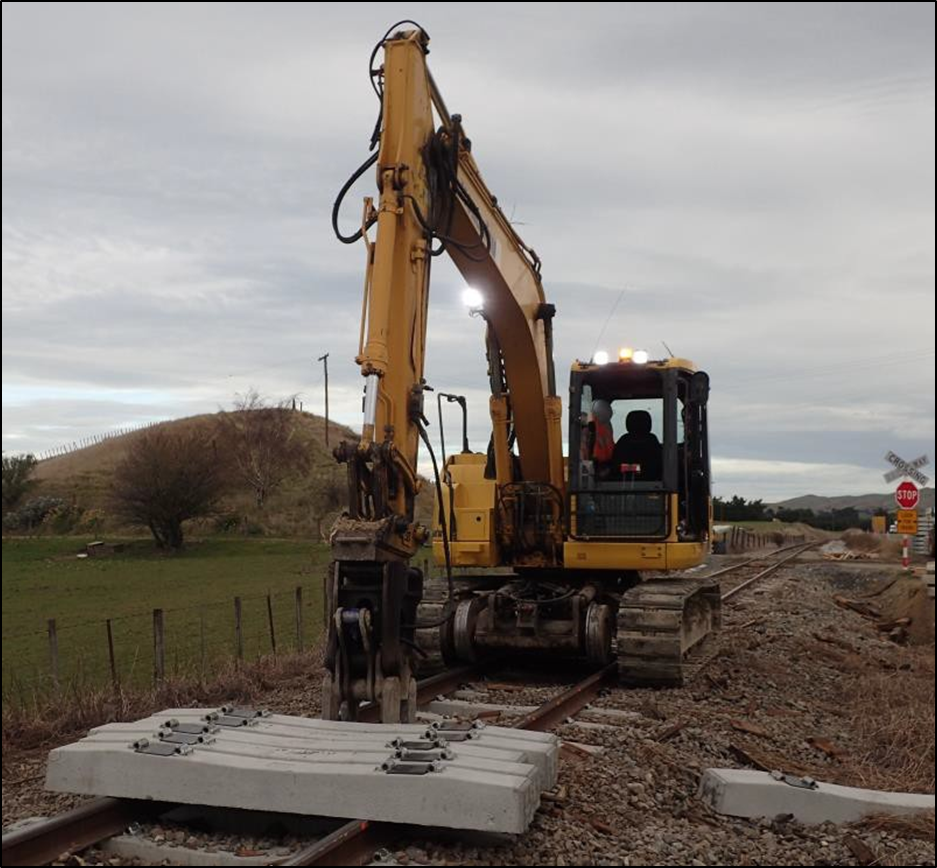
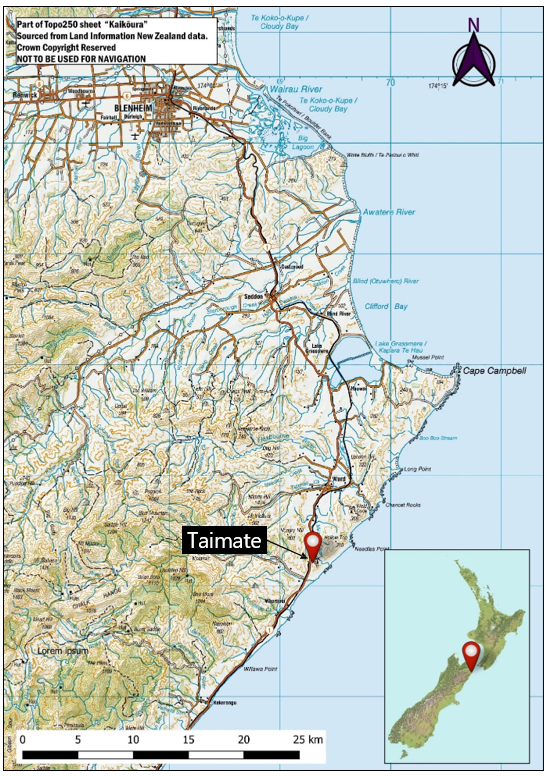
What happened
- On 5 June 2019, planned work was being undertaken to repair derailment damage between Taimate and Wharanui. A protected work area had been established, which contained two adjoining worksites and four separate workgroups. A rail protection officer was responsible for overall safety in the protected work area, and northern and southern site protectors were each responsible for one worksite, with two workgroups in each (see Figure 3).
- At approximately 0825 a work train arrived at the northern end of the protected work area and the train driver requested permission from the rail protection officer to enter the protected work area.
- The rail protection officer granted permission and the work train entered the protected work area. It travelled safely through the northern worksite but was unintentionally authorised through the southern worksite by the southern site protector while a hi-rail excavator was still on the track.
- The hi-rail excavator driver overheard the work train being authorised into the southern worksite and immediately removed the excavator and materials from the track. As a result there was no collision and no-one was injured.
Why it happened
- The daily information bulletin advised that the work train would transit completely through the protected work area before continuing to Wharanui, where it would collect concrete sleepers and then return to the worksite.
- However, the rail protection officer had misunderstood the work train’s route, believing that it would arrive at the protected work area from the north with loaded wagons of concrete sleepers and commence work once it had entered the protected work area.
- The rail protection officer very likely instructed both site protectors to leave their workgroups locked on and did not require them to return to the safe place while the work train passed through the protected work area.
- The instruction to remain locked on was challenged by one of the site protectors, but the challenge was disregarded and the rail protection officer continued with the original plan. As a result, neither of the site protectors locked off their workgroups prior to the work train entering the worksites.
- The Transport Accident Investigation Commission (Commission) noted that the New Zealand Rail Operating Rules and Procedures for protecting worksites and individual workers within workgroups were robust and would have prevented this incident, but were not adhered to on the day of the incident.
- The Commission identified that the New Zealand Rail Operating Rules and Procedures provided insufficient guidance on how to manage work trains within worksites, and did not differentiate between a train moving to a point where work needs to take place and a train carrying out its designated work as a work train. As a result, the Commission recommended that the Chief Executive of KiwiRail undertake a review of the New Zealand Rail Operating Rules and Procedures to ensure that appropriate guidance is provided for those involved in the operation of work trains.
What we can learn
- Established rules that form part of an operator’s safety management system must be followed to help reduce the risk of harm to workers. Creating local workarounds, or modifications to established rules, can, if they are not properly reviewed and assessed, lead to unintended outcomes.
- Procedures are established to ensure that tasks are completed safely using standardised approaches that have been tested and proven to work. Following approved procedures rather than relying solely on knowledge gained from previous experiences will help to ensure a reliable, safe and structured process that keeps personnel clear of harm. Supporting these procedures with a proficient use of non-technical skills, such as communication, decision-making and challenge and response, will further help to reduce the likelihood of people making mistakes and likely reduce the chance of accidents occurring.
Who may benefit
- Those working in worksites or as part of protection teams will benefit from the findings and recommendations contained in this report.
Factual information Pārongo pono
Narrative
- Two weeks prior to the incident, on 22 May 2019, a freight train had derailed, causing damage to the track between Taimate and Wharanui on the Main North Line. The damage to the track was in an area covered by the North Canterbury Transport Infrastructure Recovery alliance (NCTIR), which had been established to co-ordinate road and rail recovery work after the Kaikōura earthquake. As a result, NCTIR planned the derailment repair work and liaised with KiwiRail, contractor workgroups and worksite protection companies.
- A protected work area (PWA) had been in place for some weeks before the incident to facilitate the derailment repair work.
- On 3 June 2019 the planning team at NCTIR liaised with the rail protection officer (RPO) of the PWA to ascertain the number of site protectors the RPO required. The RPO requested that three site protectors be allocated.
- On 4 June a work train was added to the schedule for the morning of 5 June. The plan was for it to travel from Picton to the PWA to supply additional concrete sleepers. The KiwiRail daily information bulletin published on the day of the incident (see Appendix 1) detailed that the work train would collect concrete sleepers from a siding at Wharanui and deliver them to the PWA. This required the work train to pass through the entire PWA before collecting the sleepers from Wharanui, then deliver them to the PWA from the south.
- The work train required a pilot to guide it through the two worksites in the PWA. The RPO determined that two site protectors would be enough to cover the safety protection of the four workgroups within the two worksites and reallocated the third site protector to be the pilot6 for the work train.
- On the day of the incident, 5 June, each of the two worksites contained two individual workgroups. The RPO had overall control of the PWA, and the two site protectors were each assigned responsibility for two workgroups in the PWA (see Figure 3).
- Two workgroups (at workgroups 1 and 2 in Figure 3) at the 275-kilometre (km) position were within sight of the northern site protector. The remaining two workgroups (at workgroups 3 and 4 in Figure 3) were located 3 km apart. Workgroup 3, at the 271 km position, was within visual range of the designated safe place and the southern site protector. Workgroup 4 was at the 268 km position and out of sight of the southern site protector.
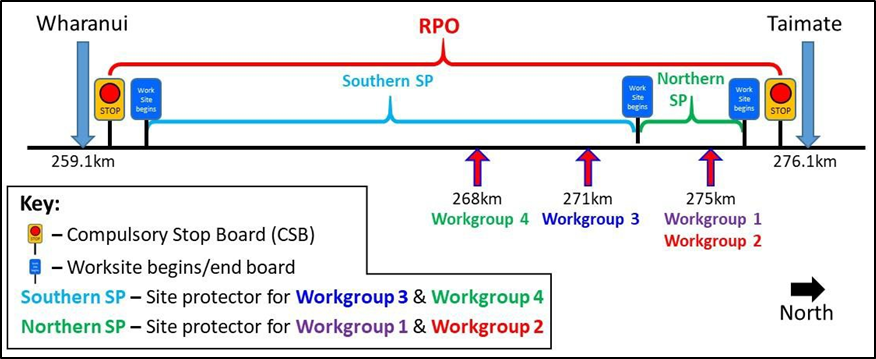
- Before the start of the shift, the RPO contacted train control to obtain a track warrant to authorise the occupation of the track to erect the PWA compulsory stop boards (CSBs). Once the CSBs were established the RPO contacted train control to cancel the track warrant. Once it was cancelled, the work area was protected by Rule 905 Compulsory Stop Boards. During the conversation with train control, the RPO was informed that the work train would arrive at the PWA at around 0930 from the north.
- At approximately 0740 the RPO, who thought the work train was arriving already loaded with sleepers, gathered together the site protectors, pilot and workgroup team leaders for a pre-shift briefing.
- The RPO’s recollection of the pre-shift briefing differed from those of others at the briefing; this is discussed further in section 3 of this report. The RPO recalled instructing both site protectors to ensure personnel were locked off for the work train movement through the worksites. However, the others at the pre-shift briefing recalled the RPO telling them that personnel were not required to lock off, nor were they required to be in the designated safe place for the movement of the work train through the PWA.
- At 0825 the work train arrived at the PWA’s northern CSB. The pilot boarded the work train and the train driver radioed the RPO to request permission to pass the northern CSB and enter the PWA.
- The RPO authorised the work train to pass the CSB under the direction of the pilot. The work train then moved past the CSB and stopped at the first worksite boards. The pilot contacted the northern site protector for permission to pass the worksite boards and pass through the worksite.
- The northern site protector gave permission for the work train to pass through the northern worksite while both workgroups remained locked on. The workgroups and northern site protector retired to a lunchroom cabin, rather than the designated safe place, until the work train had cleared the worksite.
- As the work train proceeded through the northern worksite, the pilot made a cell phone call and informed the RPO that the work train would not be stopping on the southbound trip through the PWA. This was due to the work train needing to continue to Wharanui to collect the wagons loaded with sleepers. The RPO told the pilot to continue through the PWA. The RPO then drove to Wharanui to meet the work train.
- At approximately 0840 the work train stopped at the southern worksite boards under the protection of the southern site protector. The pilot was unable to contact the southern site protector by radio, but was able to contact them by cell phone. The southern site protector asked the pilot to wait until it was confirmed that the track was safe and clear for the work train to proceed.
- The southern site protector saw that workgroup 3 had not started working on the track and radioed them to stay clear while the work train passed through. The southern site protector then radioed workgroup 4 to confirm they were off and clear of the track, and the southern site protector thought they heard confirmation that this was the case. Having concluded that both workgroups were clear of the track, the southern site protector authorised the work train to pass through the southern worksite to Wharanui.
- However, workgroup 4 had not heard the radio call from the southern site protector and as a result had not informed the site protector that a hi-rail excavator was still on the track, together with approximately six concrete sleepers (see Figure 4).
- The hi-rail excavator operator overheard on the radio that the work train had been authorised through the southern worksite and took action to remove the sleepers and the excavator from the track.
- The work train passed workgroup 4 approximately 13 minutes after being authorised past the worksite boards. The hi-rail excavator and sleepers were clear of the track and the work train continued to Wharanui.
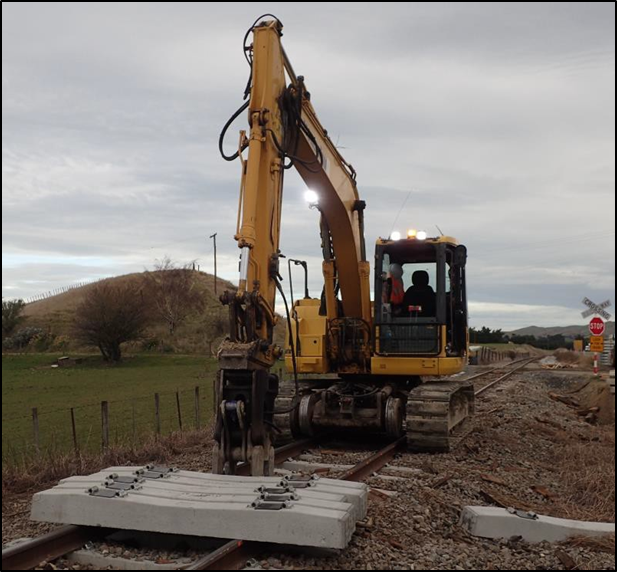
Personnel information
Contracted personnel
- The RPO, work train pilot and northern site protector worked for a subcontractor to NCTIR. All held current certification for their roles:
- the RPO had seven years’ rail experience, including 18 months’ RPO experience
- the pilot had nine years’ rail experience
-
the northern site protector had seven months’ experience in the role.
No drug and alcohol testing was conducted on these personnel because their actions were not considered contributory to the incident at the time.
KiwiRail personnel
- The work train driver was employed by KiwiRail, was based in Picton, and had nine years’ experience driving trains. They held current certification for the role.
- The hi-rail excavator operator had more than 20 years’ rail experience, worked for KiwiRail and held current certification for their role.
- The southern site protector was employed by KiwiRail, was based in Kaikōura and had four months’ experience in the role. At the time of the incident, because the southern site protector was considered to have authorised the work train through the southern worksites with the hi-rail excavator still on track, they underwent a post-incident drug and alcohol test, which returned a negative (clear) result.
Additional information
Worksites
- Whenever any maintenance or repair work is required within four metres of a rail track in New Zealand, the New Zealand Rail Operating Rules and Procedures require that appropriate protection arrangements be put in place to protect the track personnel from rail movements.
- A range of protection options are available in the rules and procedures depending on the complexity of the work and the number of worksites in a PWA. In this case Rule 905 Compulsory Stop Boards was utilised.
- The safety of those working in a PWA, and within an individual worksite in a multiple-worksite PWA, is covered by Rule 902 of the New Zealand Rail Operating Rules and Procedures.
Rule 902 – Managing multiple worksites
- Rule 902 requires everyone working on or near the track at a worksite in a PWA to lock their individual, uniquely keyed padlock onto a metal frame held by the site protector, in a procedure known as ‘locking on’ (see Figure 5). The metal frame is then held by the site protector at the defined safe place – a place where people and equipment cannot be struck by passing rail traffic.
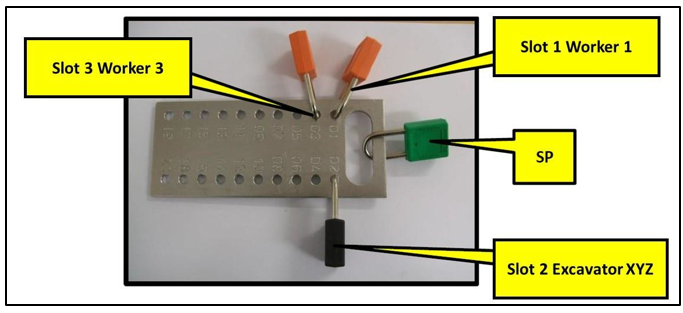
- An RPO has overall responsibility for personnel in the entire PWA. Each individual worksite or set of workgroups has an appointed site protector who is responsible for personnel safety in a specified worksite in a multiple-worksite PWA (see Figure 6).
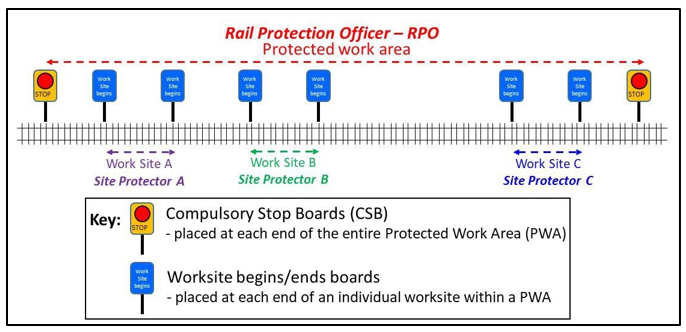
- When a work train enters a multiple-worksite PWA to deliver or collect equipment or materials, the RPO appoints a pilot to ride on the work train before authorising it to pass the CSBs. Once past the CSBs the pilot guides the train, stopping at the ‘worksite begins’ board at each worksite and requesting access into or through the worksite from the site protector.
- Rule 902 requires each site protector to ascertain that the worksite is safe for the passage of any train by calling all those who are locked on back to the designated safe place, and for everyone to remove their padlock from the metal frame before the train can be authorised to pass the ‘worksite begins’ boards.
- Once the train has either passed through the worksite or stopped within the worksite to carry out planned work, the site protector can allow the workers to lock on and return to work or assist the work train to complete the drop-off or pick-up of materials or equipment.
- In summary, Rule 902 states that no-one should be locked on for rail movements into or through a worksite.
Analysis Tātaritanga
Introduction
- The protection of workgroups that are maintaining rail track is a safety-critical process. Any confusion around the procedures to be followed, or a lack of adherence to them, can reduce significantly the level of protection afforded to track workers and create conditions that increase the likelihood of a catastrophic event occurring.
- In this case, the authorisation of a work train into a worksite while a hi-rail excavator was still on the track was a serious incident. It created the potential for a collision between the work train and the excavator, which was only averted by the actions of the excavator driver, who overheard the work train being given approval to pass through the worksite.
- The following section analyses the circumstances surrounding the event to identify those factors that increased the likelihood of the event occurring or increased the severity of its outcome. It also examines any safety issues that have the potential to affect future operations adversely.
Planning of the operation
Protection procedures
- To ensure the safety of personnel working in a PWA, Rule 902 – Managing Multiple Worksites requires all personnel to return to the designated safe place and lock off before a rail movement is authorised through the worksite.
- When interviewed, the RPO was familiar with this requirement and recalled instructing both site protectors to ensure personnel were locked off for the work train movement. However, both the site protectors, the pilot and several staff from each workgroup recalled the RPO telling them that personnel were not required to lock off. On this basis, the Transport Accident Investigation Commission (Commission) considered it very likely that the RPO told the site protectors not to lock off personnel. By incorrectly applying Rule 902, a key safety defence for protecting workers was removed.
- The KiwiRail daily information bulletin showed that the intention was for the work train to pass through the entire PWA to enable it to collect concrete sleepers from Wharanui before returning to the PWA. When interviewed, the RPO recalled thinking that the information contained in the daily information bulletin indicated that the work train would arrive from the north with loaded wagons of concrete sleepers and commence work upon entering the PWA. This may have influenced the RPO’s very likely decision to tell site protectors not to lock off personnel (see Interpretation of Rule 902 paragraphs 3.19-3.24).
Planned use of resources
- While the work train was in the PWA, the rules required that a pilot guide the work train through the individual worksites. Because the RPO believed that the work train would only be carrying out work for a few hours within the PWA, they reassigned one of the three original site protectors to act as the pilot. The RPO decided it was unnecessary to request an additional site protector, meaning the two remaining site protectors would be responsible for the two workgroups within each worksite. In addition, workgroup 4 would be out of sight of the southern site protector, who was responsible for the workgroup’s protection. This was permissible, but without everyone returning to the designated safe area with the responsible site protector and locking off, it relied on effective radio communication as the last remaining defence against a potential collision.
- In addition to the option of requesting an additional site protector to replace the pilot, the RPO had alternative options available to ensure that each of the geographically isolated workgroups were within sight of a site protector. One such option was for the RPO to temporarily be the site protector for workgroup 4 while a pilot was required for the work train. This would have allowed workgroup 4 to be visually overseen by the RPO.
Operational considerations
Non-technical skills – challenge and response
- Several participants in the pre-shift briefing recalled the southern site protector challenging the RPO’s instruction to not lock off track workers during the work train movement. However, the southern site protector recalled reluctantly agreeing not to ‘lock off’ personnel after initially challenging the instruction. The site protector, who reported to the RPO, was relatively new to the role and less experienced than the RPO. These factors made it likely that the authority gradient between the two resulted in the southern site protector’s reluctant agreement.
- In addition, there were other, more experienced personnel attending the pre-shift briefing who were trained and certified in the use of Rule 902, such as the pilot and the northern site protector. None of them challenged the RPO’s instruction or supported the southern site protector’s challenge. Had they done so effectively, the unsafe instruction may have been rectified.
- In 2012, as part of inquiry RO-2011-101, the Commission issued a recommendation (002/12) to the Chief Executive of the NZ Transport Agency that they require: the Executive of the National Rail System Standards to develop standards to ensure all rail participants meet a consistently high level of crew resource management (now known as non-technical skills); and communication to staff that includes the use of standard rail phraseology.
- Subsequent Commission reports have also highlighted the importance of non-technical skills in helping to prevent incidents and accidents occurring, and the need for KiwiRail to develop the necessary skills and create an awareness of them throughout the company. The NZ Transport Agency has updated the Commission on the status of completed and ongoing work being undertaken by KiwiRail in developing non-technical skills throughout its workforce (see section 5). As a result of the safety actions that have been taken and those that are currently underway, the Commission has not made a further recommendation regarding the development of non-technical skills.
Missed opportunity
- During the work train movement the pilot called the RPO to clarify the work train’s actual destination. This was an opportunity for the RPO to update their understanding of the work train’s route, stop the work train movement and modify the plan by requiring all the workgroups to lock off and return to their designated safe place.
- However, the opportunity to check the work train’s route was missed by the RPO, and the movement continued without track workers being properly accounted for and without their being provided with the protection that Rule 902 should have afforded them.
Radio procedures
- The work area communication plan confirmed that both radio and backup cell phone coverage between the RPO, each individual worksite and each CSB location was available.
- The southern site protector authorised the work train through the worksites while the track was still occupied. This was a result of them believing they had received radio confirmation from workgroup 4 that the track was safe for rail movements.
- However, it was likely that the southern site protector overheard a radio conversation between the other workgroups and misinterpreted this as workgroup 4 providing confirmation.
- On a single-channel open radio network, it is essential that each communicator has a unique identifier or call sign that they always use to provide clarity on who is transmitting and to whom messages are directed. On this occasion, only the site protectors had allocated call signs, which likely resulted in confusion when workgroups were communicating on the radio, and the southern site protector misidentifying the radio call.
Interpretation of Rule 902
Safety issue: The New Zealand Rail Operating Rules and Procedures did not provide guidance on how to manage work trains within a worksite and did not differentiate between a train moving to a point where work needs to take place and a train carrying out its designated work as a work train.
- Through interview and by observation, the Commission was made aware of previous occasions when workers had been allowed to stay locked on while a work train was carrying out its designated work within a worksite and needed to move a short distance at slow speed, such as the length of a wagon. This procedure had not been documented or risk assessed, and it was unclear how it had evolved.
- The plan discussed at the pre-shift meeting was like that described above. When the work train was in the correct position, the workgroup at the sleeper discharge point were to lock on with the pilot. The practice of locking on with a pilot was not documented in Rule 902.
- It was likely that the lack of documented procedures for the protection of workers when a work train was carrying out work had led to the development of locally adopted procedures. These procedures may have worked on previous occasions, but should have been formally assessed and approved before being incorporated into the relevant safety management documentation.
- The rules and procedures at the time of the incident did not define whether a train was a work train for the purpose of the rules when it departed from its depot, or whether it was a work train when it was in a position to carry out work.
- In addition, Rule 902 did not contain actions to be taken for a work train or provide procedures for the loading and unloading of multiple wagons requiring small movements of a work train. As a result, the rule was open to interpretation and modification at a local level.
- To help prevent a repeat of this incident, the requirements for work train movements in Rule 902 of the New Zealand Rail Operating Rules and Procedures should be clearly explained. This will ensure there is no need to create local procedures. The Commission has made a recommendation to KiwiRail to review Rule 902 in light of this incident and ensure that the procedures for the operation of work trains in PWAs are appropriate and provide suitable levels of protection for track workers.
Findings Ngā kitenga
- For reasons that could not be determined, the rail protection officer misunderstood the intended route of the work train.
- The rail protection officer very likely instructed the site protectors to not lock off workgroups, nor require workers to return to a safe place for a rail movement, which contrasted with the requirements of Rule 902 – Managing Multiple Worksites.
- The rail protection officer used two site protectors to protect the two worksites containing four workgroups. There were options available that would have likely allowed all the workgroups to remain in visual range of their site protectors and reduced their reliance on radio communication.
- The southern site protector misidentified a radio call, believing that workgroup 4 was clear of the track. As a result, the southern site protector permitted the work train to enter the southern worksite while a workgroup 4 hi-rail excavator was still on the track.
- The hi-rail excavator driver was monitoring communications and took action to clear the track before the work train arrived.
- Call signs were not used by individual workgroups, which very likely increased the risk of their radio calls being misidentified.
- The rail protection officer responded inappropriately to the southern site protector’s challenge of the instructions for protecting workers. The other site protectors did not challenge the rail protection officer’s instructions.
Safety issues and remedial action Ngā take haumanu me ngā mahi whakatika
General
- Safety issues are an output from the Commission’s analysis of factors that have contributed to an occurrence. They typically describe a system problem that has the potential to adversely affect future operations on a wide scale.
- Safety issues may be addressed by safety actions taken by a participant, otherwise the Commission may issue a recommendation to address the issue.
Rules and procedures around work train movements
- The New Zealand Rail Operating Rules and Procedures did not provide guidance on how to manage work trains within a worksite and did not differentiate between a train moving to a point where work needs to take place and a train carrying out its designated work as a work train.
- Without adequate guidance to manage work trains within worksites, local procedures are likely to be developed without being formally risk assessed or without reviews being undertaken. The provision of satisfactory guidance in respect of work trains will remove the need to develop local procedures.
-
Differentiating between a work train that is relocating and a work train that is carrying out its designated work is essential to ensure the safety of people working in the area and the safe operation of the train in the two conditions.
-
No action has been taken to address this safety issue. Therefore, the Commission has made a recommendation in section 6 to address this issue.
Other safety action
- Participants may take safety actions to address issues that would not normally result in the Commission issuing a recommendation.
- The following safety actions have been taken:
-
On 14 January 2017 the NZ Transport Agency updated the Commission on the progress of KiwiRail in developing non-technical skills throughout its workforce:
KiwiRail continues to develop a new non-technical skills training course and will extend past train drivers to right across the business. KiwiRail state “this project covers a programme of work to integrate non-technical skills into KiwiRail’s culture and operations targeting… safety critical roles (including contractors).” This roll-out is due to be completed in 2020.
- On 6 April 2020 the NZ Transport Agency further updated the Commission on the progress made by KiwiRail in developing and implementing non-technical skills training. The agency is currently monitoring the ongoing efforts of KiwiRail to implement a key milestone of its non-technical-skills programme, ‘NTS behaviours incorporated into learning programmes’, which is due to be completed in May 2020.
- The current status of KiwiRail’s progress in implementing its non-technical skills programme can be seen below:
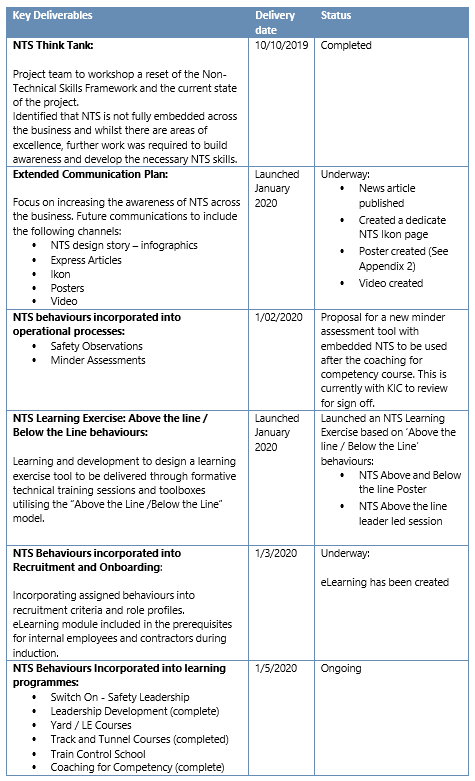
Recommendations Ngā tūtohutanga
General
- The Commission issues recommendations to address safety issues found in its investigations. Recommendations may be addressed to organisations or people, and can relate to safety issues found within an organisation or within the wider transport system that have the potential to contribute to future transport accidents and incidents.
- In the interests of transport safety, it is important that recommendations are implemented without delay to help prevent similar accidents or incidents occurring in the future.
New recommendations
- On 24 September 2020, the Commission recommended that KiwiRail undertake a review of the New Zealand Rail Operating Rules and Procedures to ensure that appropriate guidance is provided for those involved in the operation of work trains. (009/20)
-
On 2 November 2020, KiwiRail replied:
KiwiRail accepts this recommendation and are working towards this in the future.
Key lessons Ngā akoranga matua
- Established rules that form part of an operator’s safety management system must be followed to help reduce the risk of harm to workers. Creating local workarounds, or modifications to established rules, can, if they are not properly reviewed and assessed, lead to unintended outcomes.
- Procedures are established to ensure that tasks are completed safely using standardised approaches that have been tested and proven to work. Following approved procedures rather than relying solely on knowledge gained from previous experiences will help to ensure a reliable, safe and structured process that keeps personnel clear of harm. Supporting these procedures with the proficient use of non-technical skills, such as communication, decision-making and challenge and response, will further help to reduce the likelihood of people making mistakes and likely reduce the chance of accidents occurring.
Data summary Whakarāpopoto raraunga
Details
Conduct of the inquiry He tikanga rapunga
- The incident occurred at about 0840 on Wednesday 5 June 2019. The NZ Transport Agency notified the Commission of the occurrence. The Commission subsequently opened an inquiry under section 13(1) of the Transport Accident Investigation Commission Act 1990 and appointed an investigator in charge.
- A work train had been authorised to access and pass through a worksite while a hi-rail excavator was still on the track within the worksite.
- Commission investigators travelled to the incident site on Wednesday 12 June 2019 to commence the investigation.
- Commission investigators interviewed the:
- RPO
- two site protectors
- work train drivers
- work planners
- track maintenance workers
- initial investigator.
- The Commission obtained the following documents and records for analysis:
- the training records for the RPO, site protectors and train drivers
- the roster details for the work train driver
- the event recorder download data from the lead locomotive
- a recording of the communications between the train controller and the work train driver.
- On 22 July 2020 the Commission approved a draft report for circulation to six interested persons for their comment.
- The Commission received two submissions, and changes as a result of these have been included in the final report.
- On 23 September 2020 the Commission approved the final report for publication.
Glossary Kuputaka
- Compulsory stop boards (CSBs)
- A set of boards that indicates the start and finish points of an individual worksite in a PWA.
- Hi-rail vehicle
- A vehicle fitted with equipment that gives the capability to travel on both road and rail.
- Non-technical skills
- Also known as soft skills, non-technical skills go beyond the technical skills directly related to performing specific tasks. The Railway Safety and Standards Board (RSSB, United Kingdom) lists them in categories that include situational awareness, self-management, cooperation with others, communication, conscientiousness and workload management.
- Pilot (Rail)
- Guiding of a rail movement by a second person not in control of vehicle(s), generally performed when reversing.
- Protected work area
- A section of line or lines where rail personnel are carrying out activities using an approved protection method
- Rail Protection Officer (RPO)
- A person with overall responsibility for providing rail protection for a PWA. They advise all site protectors and operators/drivers of the details of the protection arrangements before commencing work or entering the PWA, authorise movements to enter or proceed through the PWA, co-ordinate the movement of rail vehicles in the PWA, and communicate with train control and supervise site protectors when more than one worksite is operating. The RPO’s name and contact details are shown on the Daily Information Bulletin, which details the locations and operating times of worksites around the rail network.
- Safe place
- A place where people and equipment cannot be struck by passing rail traffic.
- Site protector
- A site protector is a person with similar responsibilities to those of an RPO but responsible for the safety of equipment and personnel at a single worksite within a PWA. They liaise with the RPO on movements through the PWA to confirm all equipment and personnel are clear of the rail lines.
- Work train
- A non-revenue train delivering equipment or materials to or collecting them from a worksite.
- Workside boards
- A set of boards that indicates the start and finish points of an individual worksite in a PWA.A place where people and equipment cannot be struck by passing rail traffic.
Appendix 1. Extract from KiwiRail Daily Information Bulletin, 5 June 2019
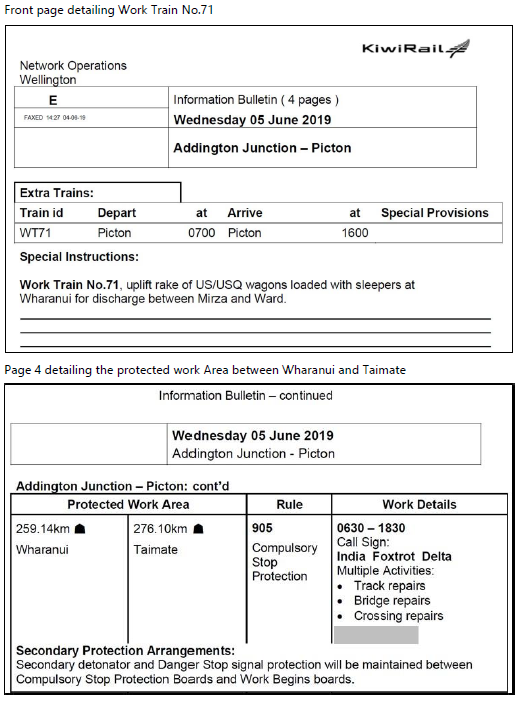
Appendix 2. KiwiRail non-technical skills poster
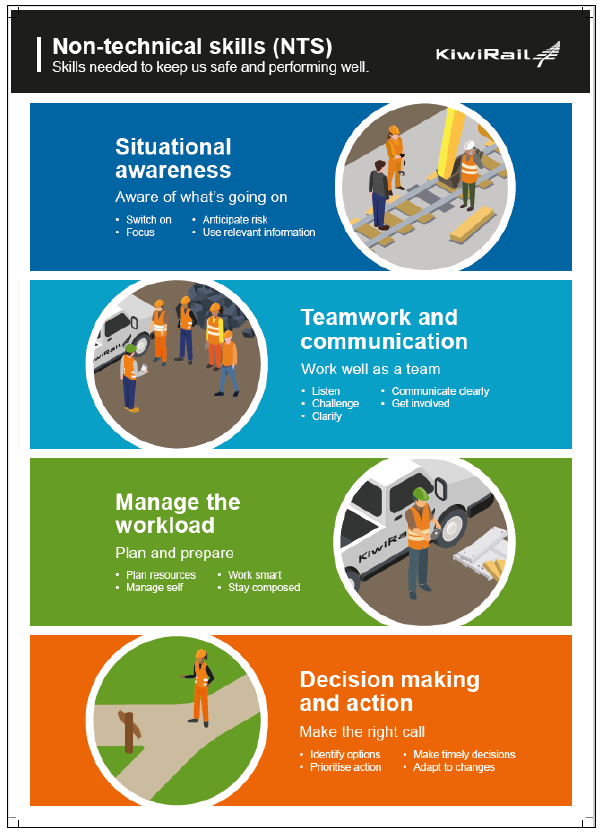
Related Recommendations
On 24 September 2020, the Commission recommended that KiwiRail undertake a review of the New Zealand Rail Operating Rules and Procedures to ensure that appropriate guidance is provided for those involved in the operation of work trains.
